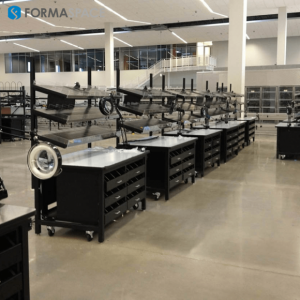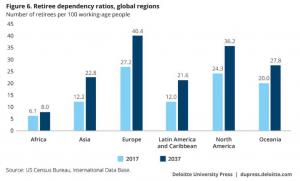
How Can STEM Programs Prepare K-12 Students for Science and Tech Job Opportunities?

Today’s world would be very different without the technology first developed in the Space Race, from the first man on the moon, to the Internet, to telecommunication satellites, and even the computer mouse.

Formaspace built these ergonomic packing and shipping workbenches for one of the largest pharmaceutical dispensing facilities in Illinois. They are designed for multi-shift operation and can be reconfigured as production needs change.
The knowledge-based economy is here. How can schools educate K-12 students for new technical and scientific job opportunities?
That month, the Soviet Union launched Sputnik, the world’s first artificial satellite. As it crossed the night sky, the American public began to ask, “what had gone wrong? How could the Russians beat us into space?”
Suddenly the excitement about Detroit’s new space-age car designs (such as the longer, lower, wider Chevrolet Impala introduced that fall) seemed irrelevant in light of an artificial satellite floating overhead, emitting its characteristic “beep beep” radio signal.
Indeed, Sputnik put an exclamation point on the argument put forward in 1955 by Rudolf Flesch in his best-selling book Johnny Can’t Read—And What You Can Do About.
The Space Race was born. In February 1958, President Eisenhower established the Advanced Research Projects Agency (later DARPA), which brought industry and government together to create some of the most important advanced technologies that power our economy today, from advanced robotics to the Internet.
And the American education system (despite criticism of some its later pedagogical approaches, such as “New Math”) benefitted greatly from the Space Race, thanks to greater investment in the study of science, technology, engineering, and mathematics – the subjects we today collectively refer to as STEM.
Sixty-seven years after Sputnik, the US is facing another crisis, the Covid-19 pandemic.
And, like the sudden appearance of Sputnik, the pandemic has exposed critical, systemic problems in the US economy and our education system.
For the first time in years, the American public has come to understand the limitations of our domestic manufacturing base. In times of emergency, we don’t have the manufacturing capacity here at home to supply urgently needed goods, such as PPE or pharmaceuticals.
But Covid-19 has also exposed a more insidious problem as well – a widespread lack of trust in science and, at times, an even willful repudiation of public health scientists and their research by those with a high school degree or less.
According to research by the Pew Institute, while a majority (54%) of Americans with a postgraduate degree have a great deal of confidence in scientists, the number drops to a minority (only 32%) among those with a high school degree (or less).
For STEM education professionals, this is an alarming development, one that is compounded by a widespread lack of scientific literacy among the general public.
One pandemic literacy issue comes to mind: while Asian and European governments (and the press) regularly discuss fluctuations in the R0 value (e.g. the basic reproduction number of the virus), this basic public health metric is rarely mentioned in the US… why is this? Are basic statistics too difficult for us to grasp in this country?
Did Economic Conditions Just Jump Ahead By A Generation?
If the American public is having trouble understanding basic math statistics, we have a major problem on our hands.
Prior to the pandemic, American companies were already facing a critical shortage of qualified STEM graduates to meet the growing demand for talent in the most rapidly growing sectors of the economy, including healthcare and pharmaceutical research, cybersecurity, advanced manufacturing, logistics, and online commerce.
As the economy recovers from the pandemic, these worker shortages will become more critical.
Why?
As a result of the pandemic, our economy is accelerating its transformation into a knowledge-based economy even faster than expected, with some analysts believing we may be jumping ahead by 10 years – or even a generation – in just a matter of months.
Retail sales jobs are disappearing, as consumers shift to home delivery. Telecommunications (think Zoom meetings) have changed work and business travel patterns, perhaps forever. Investments in automation are accelerating, which, in the short term, can reduce viral exposure in crowded factories, but also eliminate major sources of employment over the long haul.
The result is a growing income gap between tech workers and everyone else.
Could a SIX SIGMA Approach Help Improve STEM Education Policy Planning and Increase the Number of STEM students in K-12?
What can be done to help?
One strategy worth looking at is finding ways to increase the number of STEM students in K-12 education throughout the country.
Let’s use Six Sigma as our model – to evaluate the current landscape, identify best practices, set a goal, make improvements, and measure the results.
1. Identify The Problem: Why We Need To Step Up K-12 STEM Programs To Prepare Today’s Students For The Economy Of Tomorrow
We’ve touched on the economic issues surrounding STEM education earlier, but let’s get more specific.
Why is STEM education in science, technology, engineering, and mathematics so critical?
Changing demographics is one of the main reasons.
As the US population gets older, we will be relying on fewer workers as a percentage of the population to fund the programs (Social Security, Medicare) that senior Americans rely on.
We need to invest more to prepare today’s students for the jobs of tomorrow, to help them increase productivity and the economic growth we all depend on.
Economists predict that, as we enter the 2030s, STEM-focused jobs will be among the fastest growing (and best paid) job opportunities, including job titles that didn’t even exist ten years ago.
2. Measure The Status Quo: How Do US K-12 Education Program Outcomes Compare With Those Of Other Countries?
As part of our planning, we need to set a baseline.
In other words, how well is the US education program performing now, and how do we compare with other countries?
For an indication of where things stand, we look at the PISA (Programme for International Student Assessment) exam, which measures what 15-year-old students have learned in math, reading, and science. The most recent exam was in 2018, with more than 600,000 private and public school students participating, representing nearly 80 countries.
According to the exam results, the performance of fifteen-year-old US students lagged behind their international peers in reading, math, and science.
Secretary of Education Betsy DeVos expressed disappointment with the performance of the US students. “The bottom line is there has not been a single study that shows American education is improving enough,” DeVos said in a statement. “Scores have flatlined for a decade. Worse yet, scores for our most vulnerable students continue to decline. We are being outpaced not only by our global competitors like China and Russia, but also by countries like Estonia, Finland, and Canada.”
What lessons can we learn from other countries? Here are a few examples:
- China, in particular, has been investing heavily in STEM education since the 1980s, with a goal to lead the world in science. It has already surpassed the US in publishing science and engineering technical papers.
- Germany has achieved STEM success by following its German Dual Education System model, which brings industry participation directly into the school system, offering hands-on apprenticeship programs to German students with the promise of an employment position upon graduation.
- According to many surveys (including the PISA exam), Finland has been one of the top national performers in STEM education. Critics point to its unique approach, which de-emphasizes standardized testing and extensive homework assignments among the youngest students in favor of self-discovery and hands-on learning.
3. Root Cause Analysis: What’s Holding Back K-12 STEM Program Achievement In The US?
In late 2018, the government issued its STEM Education Strategic Plan, a five-year plan to help the US achieve global leadership in STEM literacy, innovation, and employment.
As the report points out, many US school districts have developed outstanding K-12 STEM programs; however many other school districts, particularly in lower-income areas, need more assistance, in the form of greater funding, improved access to more advanced computing science, and industry apprenticeships and technical learning programs for future workers.
Read more...
Julia Solodovnikova
Formaspace
+1 800-251-1505
email us here
Scholastic Achievement, As Measured By The 2018 International PISA Exam, Showed Little World-Wide Academic Improvement Over The Last Decade.
EIN Presswire does not exercise editorial control over third-party content provided, uploaded, published, or distributed by users of EIN Presswire. We are a distributor, not a publisher, of 3rd party content. Such content may contain the views, opinions, statements, offers, and other material of the respective users, suppliers, participants, or authors.



